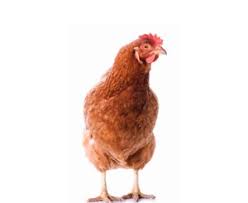Main Content

In order to keep laying hens productive through the winter months, it is vital to keep them well fed and watered, warm, healthy, and comfortable. Below are some management tips to help you properly care for your laying hens in the winter:
- Warmth: Laying hens begin to slow egg production when temperatures drop below 55 degrees F. Provide adequate warmth for the birds and try to maintain a temperature at least 40 degrees F during cold spells. This can be accomplished through insulating the floors, walls, and ceiling. Consider supplemental heat if birds cannot adequately heat the area with body heat alone. Be aware of any potential fire hazards when using heaters and heat lamps.
- Light: Provide 14 to 16 hours of light per day for your laying hens. A 60 watt incandescent light or 13 watt Compact Fluorescent or comparable LED bulb hung at 7 feet high with a white downward reflector will provide adequate light for a 200-square-foot pen. Place lights on a timer for convenience and consistency. Keep light bulbs clean for light quality and quantity.
- Spacing: Provide two to three square feet of floor space per bird. Birds need ample space for their comfort, reduced stress, and ease of movement.
- Feed: Birds typically need extra feed in cold and freezing temperatures. Supply a 14 to 17% crude protein layer ration so the birds are never without feed. A hand full of “scratch feed” (a mix of cracked corn, oats and wheat) per 10 birds can be broadcast on the litter in the late afternoon. The scratch feed will keep the birds busy and will help turn over the litter.
- Water: Provide plenty of clean water daily. Water is imperative for feed digestion and proper metabolism and chickens need to drink water in order to keep warm. Frequently change water to prevent freezing.
- Nesting Boxes: Provide adequate nest boxes (1 nest box per 5 hens) and keep bedding inside the nest box clean and dry. Pine shavings make the best nesting material. Change nest material on a regular basis and whenever an egg breaks in the nest.
- Roosting Space: Provide comfortable roosts so that all birds can roost at the same time. Provide at least 6-8 inches of linear roost space per hen.
- Ventilation: There needs to be an exchange of air for laying hens to be healthy but the poultry pen should be draft free. This can be accomplished with intake or exhaust fan(s) or natural ventilation.
- Egg Collection: Collect eggs at least twice each day or more frequently so as to prevent eggs from freezing.
- Frostbite: Birds can get frostbite on extremities (combs, wattles, and toes). Birds should be kept from walking on snow and ice. To help prevent frostbite in small flocks, apply petroleum jelly to wattles and combs.
For more information, visit this bulletin from the University of Maine Cooperative Extension.
By Jeannette Rea Keywood, State 4-H Agent, Department of 4-H Youth Development, Rutgers Cooperative Extension
Adapted from “Winter Care of Your Laying Hens” Cooperative Extension Bulletin #2217 by Richard J. Brzozowski, Poultry Specialist, University of Maine Cooperative Extension